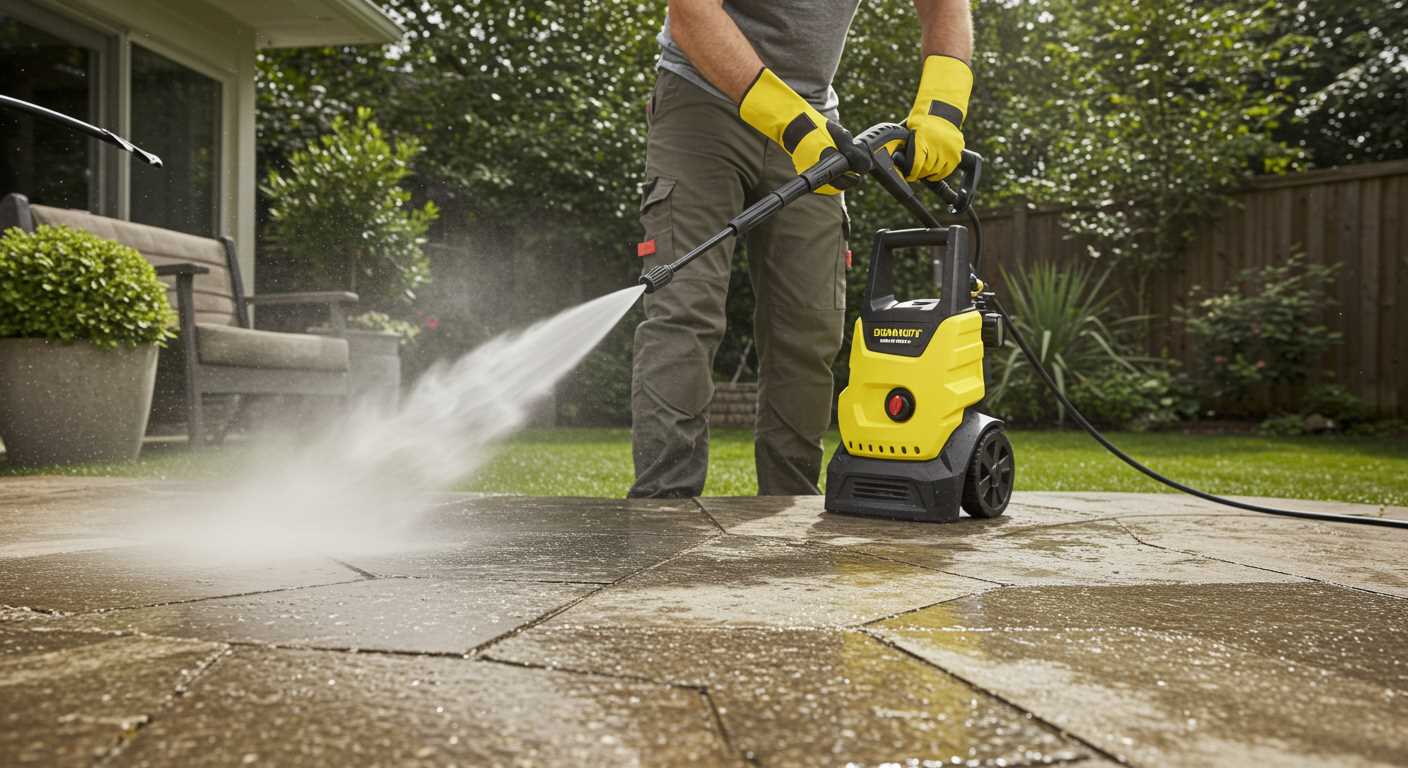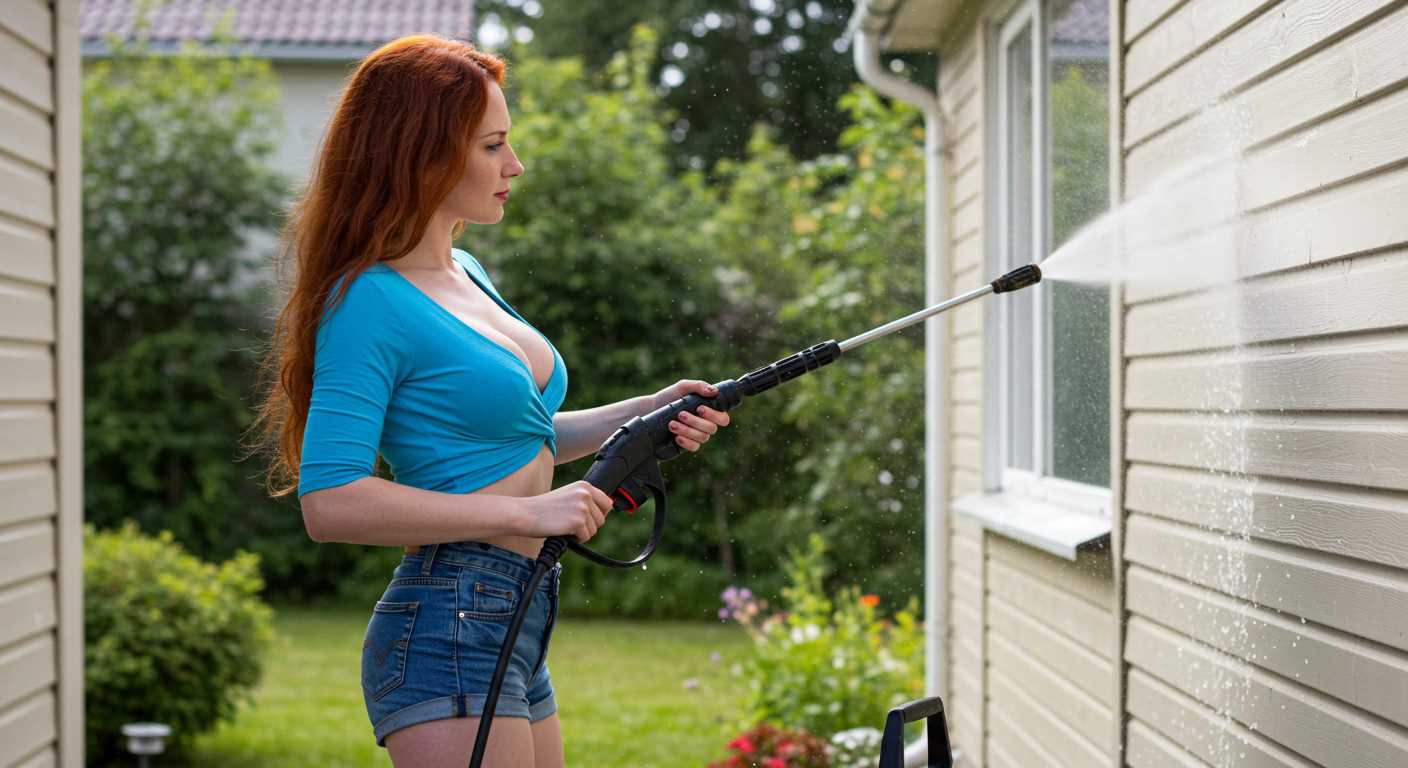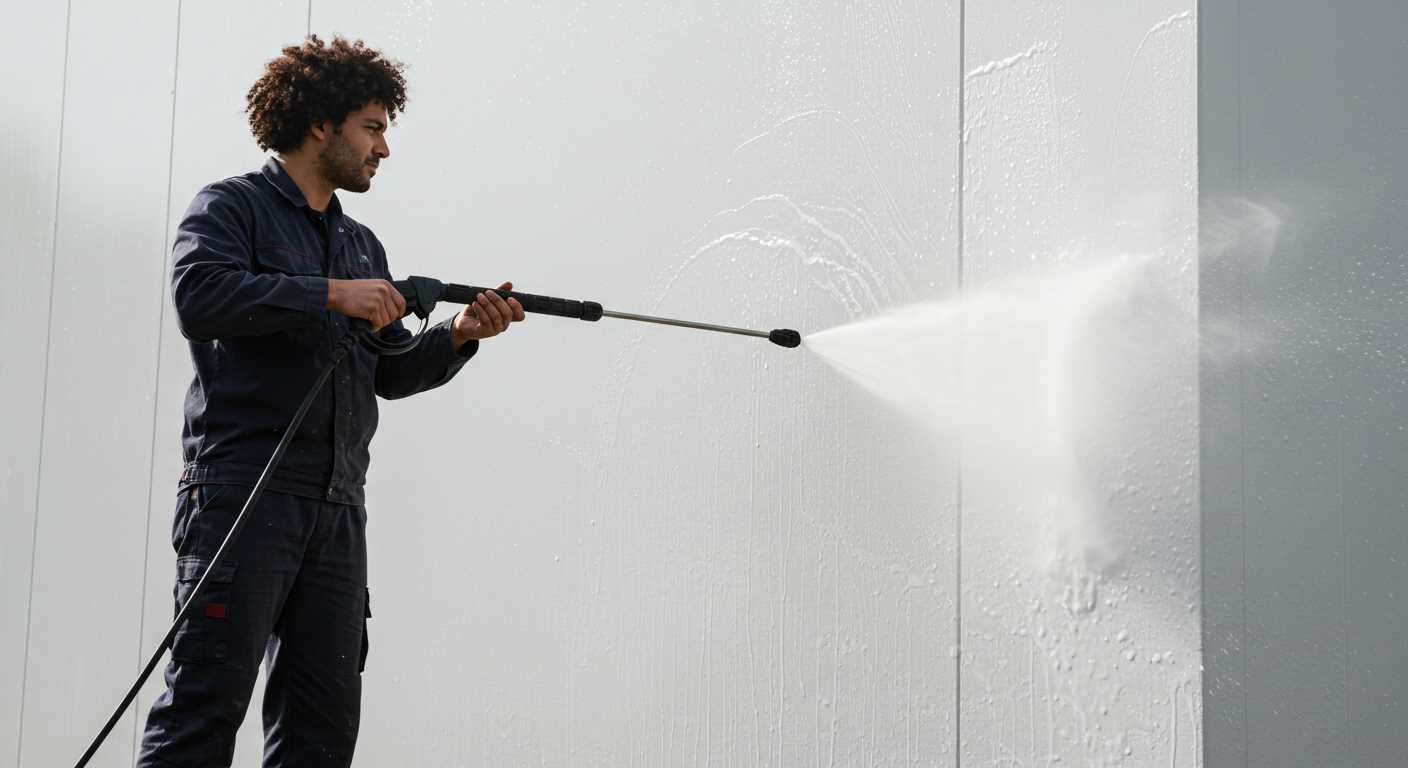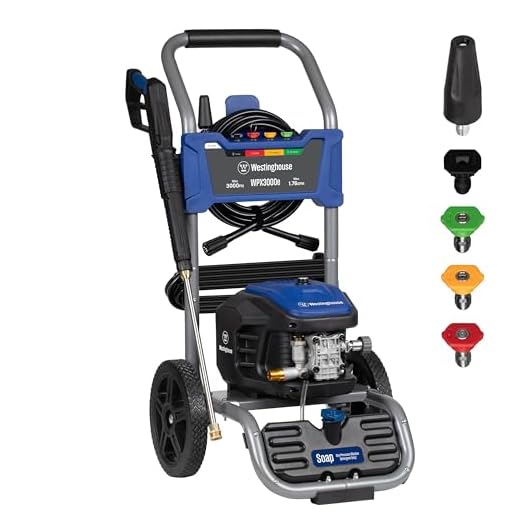



Begin by evaluating the pressure rating, expressed in PSI (pounds per square inch). Units with a PSI of 2000 to 3000 are typically sufficient for residential tasks like driveway or patio cleaning, while anything above 3000 is ideal for heavy-duty jobs. This specificity in pressure ensures you can tackle various surfaces without damaging them or using excessive water.
Next, consider the flow rate marked in GPM (gallons per minute). A higher GPM allows for quicker cleaning, as it delivers more water to the surface. A device offering 2 to 3 GPM strikes a balance between adequate water flow and efficient cleaning capability. Pairing PSI and GPM yields the overall cleaning power, making both metrics vital when selecting the right equipment.
Examine the type of motor powering the unit. Electric cleaners are typically lighter and quieter, making them suitable for smaller or residential tasks. Gas-powered varieties, although heavier and louder, provide more versatility in power and are often preferred for larger, outdoor cleaning tasks. The choice between these motor types largely hinges on your individual cleaning needs.
Check the availability of interchangeable nozzles, which allow for adjustable spray patterns. A unit that includes multiple nozzle options increases your cleaning versatility, enabling you to switch from a broad spray for cleaning patios to a concentrated stream for stubborn grime on vehicles or siding. This flexibility enhances the overall value of your cleaning equipment.
Lastly, don’t overlook the importance of build quality and portability. Devices should ideally be constructed with durable materials to endure regular use, while features like wheels and ergonomic handle designs facilitate easy transportation. These practical features contribute significantly to your overall user experience, ensuring that your cleaning tool is not only effective but also convenient to use.
Key Features to Assess in a Reliable Cleaning Device
Prioritise the motor power. A unit with a robust motor, usually rated in amps or horsepower, delivers higher pressure and flow rates, ensuring effective cleaning. Look for models offering at least 1.5 to 2.5 GPM and 1300 to 3000 PSI for versatile use.
Examine the cleaning solutions compatibility. Models able to utilise detergents can enhance cleaning efficiency, especially for stubborn stains. Ensure the device includes a detergent tank or a compatible attachment for ease of use.
Pay attention to the weight and portability. Heavier models may offer durability, but consider how easy it is to manoeuvre. A device with wheels and a comfortable handle makes tasks less tiresome.
The hose length is significant. A longer hose grants easier access to hard-to-reach areas without repositioning the unit, optimising convenience.
Check accessories and attachments. A variety of nozzles adjusts the spray pattern, allowing precise cleaning for different surfaces. Consider models with adjustable pressure settings for greater control.
Evaluate customer support and warranty. A reliable manufacturer should offer substantial warranty coverage and accessible customer service, ensuring assistance if issues arise.
Research energy efficiency. Some modern devices consume less water and electricity while providing optimal performance. This not only benefits the environment but can also reduce ongoing costs.
Review user feedback and ratings on independent platforms. Real-world experiences offer insight into reliability and overall satisfaction that specifications alone cannot provide.
Understanding Pressure Ratings: PSI and GPM Explained
Always examine the PSI (Pounds per Square Inch) and GPM (Gallons per Minute) ratings. These specifications are fundamental in determining the cleaning capability of equipment.
PSI: The Force Behind Cleaning

PSI indicates the water pressure that the device can deliver. Higher PSI means more force, which is excellent for tackling tough stains and grime. Here’s a breakdown:
- 2000-3000 PSI: Ideal for heavy-duty tasks such as stripping paint or cleaning concrete surfaces.
- 1500-2000 PSI: Sufficient for general cleaning jobs like cleaning vehicles and outdoor furniture.
- Below 1500 PSI: Best suited for delicate surfaces, including windows and siding.
GPM: Water Flow for Efficient Cleaning
GPM measures the flow rate of water. A higher GPM ensures that water covers more area quickly, enhancing cleaning efficiency. Consider the following:
- 2.5-3.5 GPM: Provides fast coverage for larger surfaces, complementing high PSI effectively.
- 1.5-2.5 GPM: Works well for smaller jobs where excessive water is not required.
Balancing both PSI and GPM is crucial. A unit with high pressure but low flow may struggle to clean effectively, while one with low pressure but high flow may not remove tough stains. I recommend a balance of at least 2000 PSI with 2.5 GPM for versatile cleaning capabilities.
Portability Features: Weighing the Importance of Size and Design
Prioritise weight and manoeuvrability. A machine under 30 kg is manageable for most users, while larger units tend to be cumbersome, making them less user-friendly.
Key Design Aspects

- Wheels: Larger, durable wheels enhance mobility across various terrains. Consider a model with 10-15 cm wheels for effortless movement, especially on uneven surfaces.
- Handle: An adjustable or collapsible handle is beneficial for storage and transport. Ensure it’s ergonomically designed for comfort during extended use.
- Frame Material: Lightweight materials, such as plastic or aluminium, contribute to lower weight without sacrificing durability. Look for reinforced structures to withstand wear and tear.
Functional Features
- Storage Solutions: Integrated storage for hoses and nozzles simplifies your setup and reduces clutter. Check for hooks or compartments to keep everything organised.
- Compact Design: Space-efficient designs allow for easier transportation and storage. Opt for models that can fit in car boots or small storage areas.
- Versatile Attachments: Interchangeable nozzles or brushes can increase effectiveness while maintaining a manageable size and weight.
Assessing these factors will optimise your cleaning experience and ensure you select a unit that meets your portability needs effectively.
Investigating Nozzle Options: Versatility for Different Tasks
Choosing the right nozzle can transform cleaning tasks, allowing for an adaptable approach to various surfaces and grime types. I highly recommend opting for models equipped with interchangeable nozzles that cater to distinct applications. This versatility is invaluable, especially if you tackle diverse projects, from washing vehicles to cleaning patios.
Generally, nozzles fall into a few key categories: fan spray nozzles, rotary nozzles, and soap nozzles. Fan spray nozzles are available in different degrees, typically ranging from 0° to 40°. A 0° nozzle produces a concentrated jet for tough stains, while a 40° nozzle covers larger areas with a gentler spray, suitable for delicate surfaces.
The rotary nozzle combines the power of a narrow jet with a swirling motion, making it exceptionally effective for stubborn grime. When utilising this attachment, be cautious, as it can damage softer materials.
Soap nozzles are another critical addition. They allow for easy application of cleaning detergents. Always ensure your model supports siphoning detergent through the nozzle for optimal performance.
Additionally, consider nozzles designed for specific tasks, such as surface cleaner attachments, which can provide a uniform cleaning experience over flat surfaces. Investing in a unit with a versatile nozzle set will elevate your cleaning efficiency, enabling seamless transitions between tasks.
In summary, the right selection of nozzles enhances functionality, simplifies cleaning processes, and ensures better results across various materials. Prioritising flexibility can save you valuable time and effort, allowing each cleaning session to be effective and straightforward.
Motor Power: Choosing Between Electric and Gas Models
When selecting a unit, consider motor power closely. Electric models typically range from 1,500 to 2,500 watts, offering sufficient force for light to medium tasks. These machines operate quietly and require minimal maintenance, making them suitable for residential use.
Conversely, gas models boast greater power, usually between 2,500 and 4,000 watts. They excel at handling heavy-duty jobs, including large driveways or commercial settings. Gas engines provide greater mobility, as they don’t rely on electrical outlets, allowing for extensive cleaning across larger properties.
The chart below summarises key differences between electric and gas-operated machines:
| Feature | Electric Model | Gas Model |
|---|---|---|
| Power range | 1,500 – 2,500 watts | 2,500 – 4,000 watts |
| Noise Level | Low | High |
| Mobility | Limited (cord-dependent) | High (fuel-dependent) |
| Maintenance | Minimal | Moderate (oil changes, tune-ups) |
| Best Uses | Residential cleaning tasks | Heavy-duty outdoor projects |
Determine your cleaning requirements before making a final decision. If portability and raw power are priorities, a gas model may be your best bet. For general household maintenance, electric machines will likely suffice, while offering ease of use and storage.
Durability Considerations: Materials and Build Quality
Prioritise models incorporating high-quality materials such as sturdy plastics, galvanised steel, or aluminium. The housing should resist corrosion, especially if you operate in moist or harsh environments. Evaluate the components: brass fittings tend to outlast plastic, reducing the likelihood of leaks over time.
Frame and Design
A robust frame enhances stability and protects essential components. Look for reinforced structures that can withstand stress during operation. A compact yet solid design aids in reducing vibration, which often contributes to wear and tear. Pay attention to the wheels and their material; durable, non-flat wheels facilitate mobility and prevent damage on uneven terrain.
Motor Longevity
Examine the motor type, as electric units often provide lower maintenance than their gas counterparts. Opt for a model with an induction motor; these typically run cooler and more efficiently, adding to the unit’s lifespan. Read user reviews to ascertain common durability issues and check for warranty offers that reflect manufacturer confidence in their product.
Essential Accessories: What to Include for Enhanced Performance
Investing in the right accessories can significantly enhance the cleaning power and versatility of your equipment. A quality surface cleaner, for instance, allows you to clean large flat surfaces swiftly, delivering uniform results without streaks.
Another important addition is a turbo nozzle. This tool focuses the water stream, combining high pressure with rotational action, making it perfect for removing stubborn grime and dirt in hard-to-reach areas.
Extension Wands

Extension wands provide the reach needed for tall structures and rooftops. They eliminate ladder work, ensuring safety while maintaining efficiency. Look for telescoping models that can adapt to various tasks.
Detergent and Soap Dispensers

A dedicated detergent dispenser enhances cleaning capabilities. Using the appropriate soap for specific surfaces boosts cleaning power and can prolong the life of your equipment. Ensure compatibility with your unit to avoid damage.
Moreover, a hose reel can help organise your setup, preventing tangling and making storage more manageable. Protecting your hoses from wear extends their lifespan and ensures consistent performance.
Finally, consider protective gear such as safety goggles and gloves. They keep you safe from debris and high-pressure spray, enhancing the overall cleaning experience.
Evaluating User Reviews and Brand Reputation

Focusing on genuine user feedback is critical. It’s unwise to solely rely on promotional content. Seek out comprehensive reviews across various platforms. Pay close attention to both positive and negative comments, noting recurring themes like performance, ease of use, and reliability.
Analysis of User Feedback
Assess the frequency of specific praises or complaints. If multiple users mention issues during assembly or operational difficulties, that can be a significant red flag. Quantify the overall satisfaction level; a product with a high ratio of favourable reviews might be more reliable than one with mixed feedback.
Brand Reputation and Longevity
Research each manufacturer’s history and customer service record. Established brands often offer superior support and a wider array of parts and accessories. Look for companies that actively engage with their customers, addressing concerns and questions promptly.
To determine reliability, consult third-party websites specialising in product comparisons and ratings. Verify that the brand has a solid standing within the cleaning equipment sector. A company that’s been around for several years is often a safer choice than a newcomer without a proven track record.
In conclusion, thorough research into user reviews and brand reputation will provide a clearer picture of a model’s true performance before making an investment.








